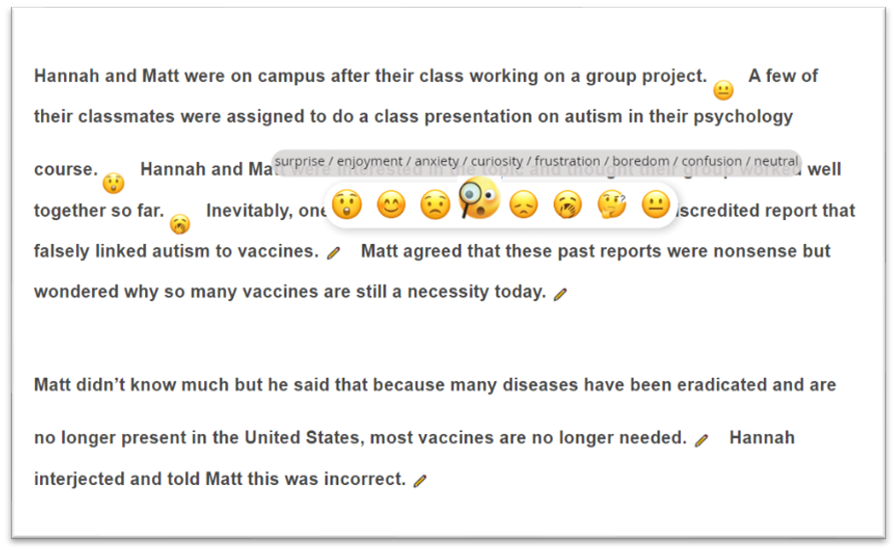How do emotions experienced in the moment shape what you learn, especially when confronted with misinformation?
Published in Behavioural Sciences & Psychology and Education

“Emotions are the experiential glue of learning environments in the 21st century” — Dr. Arthur C. Graesser (2020)
With the growing societal impact of misinformation, refutation texts—carefully structured passages that challenge misconceptions through clear explanations —have become a widely used approach in education and science communication. Yet despite their prevalence, surprisingly little attention has been given to the role of emotion in learning from these texts. Although decades of research have explored the cognitive processes involved in reading refutation texts, the emotional dimension— particularly the real-time emotions experienced during reading—remains largely unexplored. This paper addresses that gap by introducing DynamicEmo, an innovative method for measuring epistemic emotions—those linked to thinking and learning—in real time as reading unfolds.
Drawing on the Knowledge Revision Components (KReC) framework (Kendeou & O’Brien, 2014) and extending the work of Trevors and Kendeou (2020), we move beyond traditional self-report survey research conducted with undergraduate samples by using online data collection with a broader adult population. Specifically, participants were presented with four types of texts: standard (neutral) refutation, positive refutation, negative refutation, and non-refutation texts. While reading, they used DynamicEmo to report the emotions they experienced in each moment.
💬 What is a refutation text?
- Present a common misinformation
Example: “Some say vaccines are unnecessary because most people are already vaccinated...” - Explicitly refute that misinformation
Example: “But that’s not true” - Provide the correct information with detailed explanations
Example: “Herd immunity relies on high coverage—‘hiding in the herd’ puts everyone at risk…”
Refutation texts are popularly used in science education, public health campaigns, and debunking efforts. However, we’ve paid little attention to how they make readers feel, especially during those crucial moments when misinformation is clearly corrected and explanations are provided.
🛠️ Introducing DynamicEmo
To capture the emotions people experience in real time while reading, we developed DynamicEmo—a computer-based tool that lets participants indicate their feelings sentence by sentence. This approach provides fine-grained data on multiple emotions and their shifts throughout a single text.
How it works? As participants read each sentence, they click on an emoji that best represents how they feel—curiosity, confusion, frustration, anxiety, boredom, surprise, or enjoyment. It’s like adding a reaction emoji to every line of a text, but instead of just sharing feelings, it helps researchers build a detailed emotional “map” of the reading experience. DynamicEmo offers insight into how epistemic emotions fluctuate across a text, especially during moments of conflict or correction.
 The DynamicEmo measure
The DynamicEmo measure
Why this matters? Most studies measure learners’ emotions after the fact—asking them how they felt once they’ve finished reading. But this approach misses the nuance and timing of emotional responses, which can change sentence by sentence. DynamicEmo solves that problem. It’s:
- 💻 Scalable and online-friendly — no lab equipment needed
- 🎯 Fine-grained — works at the sentence or paragraph level
- 😌 Low cognitive load — intuitive emoji tagging
With DynamicEmo, researchers can finally explore the temporal flow of emotions, seeing not just what emotions learners experience, but when, and in response to which kinds of content.
🔍 What we found
- Refutation texts work
Participants who read refutation texts—whether framed in neutral, positive, or negative tones—scored significantly higher on knowledge posttests compared to those who read non-refutation texts. This effect was consistent across both explanation-based and combined test scores, even when prior knowledge was accounted for.
- Insights into how emotions unfold while reading
Paragraph-level analysis revealed that segments presenting misinformation followed by corrections elicited activating emotions such as curiosity and confusion, while reducing deactivating emotions like boredom. In short, moments of conflicting information presented were also moments of emotional engagement.
- Emotions toward the final correction matter
Sentence-level analysis of emotion data revealed that when participants experienced negative emotions during the correct-outcome sentence (the final affirmation of corrective information), they were less likely to revise their misconceptions. This finding highlights the important role emotions play in engaging with key corrective statements.
🧪 Behind the scenes: innovation born from a pandemic
One of the most interesting aspects of this study is how it came to life, driven by necessity. Yi-Lun Jheng, the first author, was pursuing her PhD when the pandemic hit. Like many researchers in the “pandemic generation”, she faced a key challenge: how to study emotions in a more dynamic way without access to a lab or specialized equipment. Instead of putting her work on hold, she posed a simple but powerful question: “What if I just ask people how they feel—right in the moment they’re experiencing it?” That spark led to the creation of DynamicEmo—a lightweight, fully online tool that lets participants report their emotions in real time as they read. As the study shows, this fresh approach not only works—it provides clear, meaningful insights into the emotional experience of learning.
💡 Final thoughts
In today’s emotionally charged information landscape, how learners feel while reading matters deeply. Emotions like curiosity, confusion, frustration, or anxiety can subtly influence whether people accept new information, reject it, or simply tune out. That’s why understanding the emotional journey of learning, especially when confronting misinformation, is essential.
The DynamicEmo tool offers a powerful new lens for researchers, educators, and communicators to study this journey in real time. By capturing experienced emotions with greater granularity, it reveals how emotions influence belief change or knowledge revision and at what points different types of information have an effect. This insight paves the way for more emotionally attuned interventions. For example, if the system detects negative emotions while a participant reads a correct-outcome sentence in a refutation text, it could immediately offer supportive resources, such as explanatory notes for analytical thinkers or a pop-up discussion window where learners can share doubts with educators, with their input logged for follow-up.
Looking ahead, as emotionally adaptive learning systems and AI-powered tutoring platforms become increasingly common, tools like DynamicEmo will play a crucial role. Real-time, emotion-tracking tools can tailor learning experiences to individual needs, making education not only more effective but also more human-centered. In an age where misinformation spreads rapidly and emotions play a central role in engagement, this approach may be key to fostering more resilient and informed societies.
📄 Please read the full paper here
Jheng, Y. L., Catrysse, L., Van de Cruys, S., Kendeou, P., Poels, K., & Gijbels, D. (2025). Investigating epistemic emotions experienced while reading refutation texts through a fine-grained measure of emotion. npj Science of Learning, 10(1), 1-11.
Follow the Topic
-
npj Science of Learning

An online open access peer-reviewed journal dedicated to research on all aspects of learning and memory – from the genetic, cellular and molecular basis, to understanding how children and adults learn through experience and formal educational practices.
Related Collections
With Collections, you can get published faster and increase your visibility.
Effects of lifestyle behaviours on learning and neuroplasticity
Publishing Model: Open Access
Deadline: Mar 09, 2026
Reimagining Teaching and Learning in the Age of Generative AI Agents
Publishing Model: Open Access
Deadline: Jul 13, 2026




Please sign in or register for FREE
If you are a registered user on Research Communities by Springer Nature, please sign in